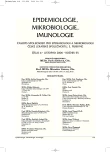Prevalence of Hepatitis G Virus (HGV) in Intravenous Immunoglobulin Recipients in the Czech Republic
Authors:
M. Sobotková 1; J. Bartůňková 1; J. Litzman 2; R. Zachová 1; D. Jílek 3; O. Kryštůfková 4; V. Němeček 5; E. Vernerová 1; A. Šedivá 1
Authors‘ workplace:
Ústav imunologie UK 2. LF a FN Motol, Praha
1; Ústav klinické imunologie a alergologie, nemocnice u sv. Anny, Brno
2; Zdravotní ústav se sídlem v Ústí nad Labem
3; Revmatologický ústav, Praha
4; Státní zdravotní ústav, Praha
5
Published in:
Epidemiol. Mikrobiol. Imunol. 55, 2006, č. 4, s. 136-139
Overview
The prevalence of hepatitis G virus (HGV) in the serum of intravenous immunoglobulin (IVIG) recipients was studied and risk related to HGV positivity was considered. Although its pathogenicity is unclear, HGV is likely to cause liver disease or lymphoproliferation. Twenty (23 %) of 86 tested IVIG patients were HGV RNA positive. Of the HGV positive patients, three (15 %) showed mild elevation of liver enzymes and one (5 %) was diagnosed with chronic lymphatic leukaemia prior to the institution of IVIG replacement. It can be concluded that the HGV prevalence among IVIG recipients is high but is not associated with signs of either liver disease or lymphoproliferation.
Key words:
hepatitis G virus – intravenous immunoglobulins – common variable immunodeficiency – X-linked agammaglobulinemia – hepatitis C virus – hepatitis B virus.
Labels
Hygiene and epidemiology Medical virology Clinical microbiologyArticle was published in
Epidemiology, Microbiology, Immunology

2006 Issue 4
Most read in this issue
- Mumps – a Reemerging Infection? The Current Incidence of Mumps in the East Bohemian Region in the Czech Republic
- Microbiology Online – Interactive Learning and a New Discussion Forum for Microbiology Teachers
- Nontuberculous Mycobacteria and Incidence of Mycobacterioses in Prague in 1999–2004
- Prevalence of Hepatitis G Virus (HGV) in Intravenous Immunoglobulin Recipients in the Czech Republic
